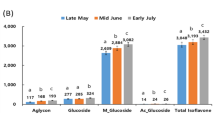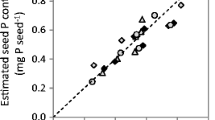Abstract
Soybean seed isoflavones are affected by various factors, but their responses to phosphorus (P) fertilization is largely unknown. A field experiment was conducted at Jackson and Milan in Tennessee from 2008 to 2010 to investigate the effects of P application rates on concentrations and production of individual and total isoflavone in the form of aglycones in soybean seeds on low and high P soils under no-tillage. Five P application rates (0, 10, 20, 30, and 40 kg P ha−1) plus the University of Tennessee recommended P fertilizer rate based on initial soil-test P were arranged in a randomized complete block design with four replicates. Phosphorus application rates exerted more frequent and greater impacts on aglycone concentrations on the low testing P soil at Milan, particularly under the dry year of 2008. Application of 10–20 kg P ha−1 was adequate for producing high individual and total aglycone concentrations in seeds on the low testing P soil. Genistein concentration was more responsive to P fertilization than daidzein and glycitein concentrations. Individual aglycone concentrations were positively correlated (r = 0.25–0.91) among each other. Total aglycone was positively correlated with seed protein but not with oil in concentration. In conclusion, pre-plant fertilization of 10–20 kg P ha−1 is frequently beneficial for producing high concentrations of individual and total aglycones in soybean seeds on low P soils, particularly under dry years, without any significant reductions in other key quality attributes such as protein or oil.


Similar content being viewed by others
References
Al-Tawaha AM, Seguin P, Smith DL, Bonnell RB (2007) Irrigation level affects isoflavone concentrations of early maturing soya bean cultivars. J Agron Crop Sci 193:238–246
AOAC, Official Method 2001.10 (2002) Determination of isoflavones in soy and selected foods containing soy, AOAC Int. 84:1865
Arjmandi BH, Getlinger MJ, Goyal NV, Alekel L, Hasler CM, Juma S et al (1998) Role of soy protein with normal or reduced isoflavone content in reversing bone loss induced by ovarian hormone deficiency in rats. Am J Clin Nutr 68:1358–1363
Barion G, Hewidy M, Mosca G, Vamerali T (2010) Intraspecific variability for soybean cotyledon isoflavones in different cropping and soil conditions. Eur J Agron 33:63–73
Bellaloui N, Smith JR, Ray JD, Gillen AM (2009) Effect of maturity on seed composition in the early soybean production system as measured on near-isogenic soybean lines. Crop Sci 49:608–620
Bellaloui N, Mengistu A, Fisher DK, Abel CA (2012) Soybean seed composition constituents as affected by drought and phomopsisin phomopsis susceptible and resistant genotypes. J Crop Improv 26:428–453
Bennett JO, Yu O, Heatherly LG, Krishnan HB (2004) Accumulation of genistein and daidzein, soybean isoflavones implicated in promoting human health is significantly elevated by irrigation. J Agric Food Chem 52:7574–7579
Boydak E, Alpaslan M, Hayta M, Gercek S, Simsek M (2002) Seed composition of soybeans grown in the Harran region of Turkey as affected by row spacing and irrigation. J Agric Food Chem 50:4718–4720
Bruns HA (2017) Soybean micronutrient content in irrigated plants grown in the Midsouth. Commun Soil Sci Plant Anal 48(7):808–817
Caldwell CR, Britz SJ, Mirecki RM (2005) Effect of temperature, elevated carbon dioxide, and drought during seed development on the isoflavone content of dwarf soybean [Glycine max (L.) Merrill] grown in controlled environments. J Agric Food Chem 53(4):1125–1129
Carrera CS, Dardanelli JL (2016) Changes in the relationship between temperature during the seed-filling period and soya bean seed isoflavones under water-deficit conditions. J Agron Crop Sci 202:421–432
Carrera C, Martinez MJ, Dardanelli J, Balzarini M (2011) Environmental variation and correlation of seed components in nontransgenic soybeans: protein, oil, unsaturated fatty acids, tocopherols, and isoflavones. Crop Sci 51:800–809
Carrera CS, Dardanelli JL, Soldini DO (2014) Genotypic and environmental variation in seed nutraceutical and industrial composition of non-transgenic soybean (Glycine max) genotypes. Crop Pasture Sci 65:1311–1322
Charron CS, Allen FL, Johnson RD, Pantalone VR, Sams CE (2005) Correlations of oil and protein with isoflavone concentration in soybean [Glycine max (L.) Merr.]. J Agric Food Chem 53(18):7128–7135
Chennupati P, Seguin P, Liu W (2011) Effects of high temperature stress at different development stages on soybean isoflavone and tocopherol concentrations. J Agric Food Chem 59:13081–13088
Chiari L, Piovesan ND, Naoe LK, Jose IC, Viana JMS, Moreira MA, de Barros EG (2004) Genetic parameters relating isoflavone and protein content in soybean seeds. Euphytica 138:55–60
Eiffe EJ (2012) The synthesis of novel, biologically active isoflavone analogues. Ph.D. dissertation. University of New South Wales, Kensington, Australia
Eldridge AC, Kwolek WF (1983) Soybean isoflavones: effect of environment and variety on composition. J Agric Food Chem 31:394–396
FAO (2014) Faostat crops. http://www.fao.org/faostat/en/#data/QC
Freiria GH, Lima WF, Leite RS, Mandarino JMG, Silva JB, Prete CEC (2016) Productivity and chemical composition of food-type soybeans sown on different dates. Acta Sci Agron 38(3):371–377
Gutierrez-Gonzalez JJ, Guttikonda SK, Tran LP, Aldrich DL, Zhong R, Yu O, Nguyen HT, Sleper DA (2010) Differential expression of isoflavone biosynthetic genes in soybean during water deficits. Plant Cell Physiol 51(6):936–948
Han Y, Li D, Zhao G, Zhao X, Jiang Z, Hu H et al (2016) Dynamic quantitative trait loci underlies isoflavone accumulation in soybean seed. Plant Breed 135:335–341
Hoeck JA, Fehr WR, Murphy PA, Welke GA (2000) Influence of genotype and environment on isoflavone contents of soybean. Crop Sci 40:48–51
Kim EH, Lee OK, Kim JK, Kim SL, Lee J, Kim SH et al (2014) Isoflavones and anthocyanins analysis in soybean (Glycine max (L.) Merill) from three different planting locations in Korea. Field Crops Res 156:76–83
Kochs G, Grisebach H (1986) Enzymic synthesis of isoflavones. Eur J Biochem 155:311–318
Lee SJ, Yan W, Ahn JK, Chung IM (2003) Effects of year, site, genotype and their interactions on various soybean isoflavoens. Field Crops Res 81:181–192
Lozovaya VV, Lygin AV, Ulanov AV, Nelson RL, Daydé J, Widholm JM (2005) Effect of temperature and soil moisture status during seed development on soybean seed isoflavone concentration and composition. Crop Sci 45:1934–1940
Mannan MA (2014) foliar and soil fertilization effect on seed yield and protein content of soybean. Bangladesh Agron J 17(1):67–72
Maria John KM, Natarajan S, Luthria DL (2016) Metabolite changes in nine different soybean varieties grown under field and greenhouse conditions. Food Chem 211:347–355
Messina M (1995) Modern applications for an ancient bean: soybeans and the prevention and treatment of chronic disease. J Nutr 125:567–569
Morrison MJ, Cober ER, Saleem MF, McLaughlin NB, Frégeau-Reid J, Ma BL et al (2008) Changes in isoflavone concentration with 58 years of genetic improvement of short-season soybean cultivars in Canada. Crop Sci 48:2201–2208
Murphy SE, Lee EA, Woodrow L, Seguin P, Kumar J, Rajcan I, Ablett GR (2009) Association of seed and agronomic traits with isoflavone levels in soybean. Can J Plant Sci 89:477–484
Osborne SL, Riedell WE (2006) Starter nitrogen fertilizer impact on soybean yield and quality in the northern Great Plains. Agron J 98:1569–1574
Primomo VS, Poysa V, Ablett GR, Jackson CJ, Rajcan I (2005) Agronomic performance of recombinant inbred line populations segregating for isoflavone content in soybean seeds. Crop Sci 45:2203–2211
Rasolohery CA, Berger M, Lygin AV, Lozovaya VV, Nelson RL, Daydé J (2008) Effect of temperature and water availability during late maturation of the soybean seed on germ and cotyledon isoflavone content and composition. J Sci Food Agric 88:218–228
Sato T, Equchi K, Hatano T, Nishiba Y (2015) Use of near-infrared reflectance spectroscopy for the estimation of the isoflavone contents of soybean seeds. Plant Prod Sci 11(4):481–486
Savoy HJ, Joines D (2009) Lime and fertilizer recommendations for the various crops of Tennessee. Chapter II. Agronomic crops. http://soilplantandpest.utk.edu/pdffiles/soiltestandfertrecom/chap2-agronomic_mar2009.pdf. Accessed 12 Mar 2018
Seguin P, Zheng W (2006) Potassium, phosphorus, sulfur, and boron fertilization effects on soybean isoflavone content and other seed characteristics. J Plant Nutr 29:681–698
Seguin P, Zheng W, Smith DL, Deng W (2004) Isoflavone content of soybean cultivars grown in eastern Canada. J Sci Food Agric 84:1327–1332
Smallwood CJ, Nyinyi CN, Kopsell DA, Sams CE, West DR, Chen P, Kantartzi SK, Cregan PB, Hyten DL, Pantalone VR (2014) Detection and confirmation of quantitative trait loci for soybean seed isoflavones. Crop Sci 54:595–606
Steele CL, Gijzen M, Qutob D, Dixon RA (1999) Molecular characterization of the enzyme catalyzing the aryl migration reaction of isoflavonoid biosynthesis in soybean. Arch Biochem Biophys 367:146–150
Szeja W, Grynkiewicz G, Rusin A (2017) Isoflavones, their glycosides and glycoconjugates. Synthesis and biological activity. Curr Org Chem 21:218–235
Tepavčević V, Atanacković M, Miladinović J, Malenčić D, Popović J, Cvejić J (2010) Isoflavone composition, total polyphenolic content, and antioxidant activity in soybeans of different origin. J Med Food 13(3):657–664
Tsukamoto C, Shimada S, Igita K, Kudou S, Kokubun M, Okubo K, Kitamura K (1995) Factors affecting isoflavone content in soybean seeds: changes in isoflavones, saponins, and composition of fatty acids at different temperatures during seed development. J Agric Food Chem 43:1184–1192
Wang HJ, Murphy PA (1994) Isoflavone composition of American and Japanese soybeans in Iowa: effects of variety, crop year, and location. J Agric Food Chem 42:1674–1677
Wang C, Sherrarda M, Pagadalaa S, Wixon R, Scott RA (2000) Isoflavone content among maturity group 0 to II soybeans. J Am Oil Chem Soc 77(5):483–487
Whent M, Hao J, Slavin M, Zhou M, Song J, Kenworthy W, Yu LL (2009) Effect of genotype, environment, and their interaction on chemical composition and antioxidant properties of low-linolenic soybeans grown in Maryland. J Agric Food Chem 57:10163–10174
Wilcox JR, Shibles RM (2001) Interrelationships among seed quality attributes in soybean. Crop Sci 41:11–14
Wu HJ, Deng JC, Yang CQ, Zhang J, Zhang Q, Wang XC et al (2017) Metabolite profiling of isoflavones and anthocyanins in black soybean [Glycine max (L.) Merr.] seeds by HPLC-MS and geographical differentiation analysis in Southwest China. Anal Methods 9:792–802
Yin X, Vyn TJ (2005) Relationships of isoflavone, oil, and protein in seed with yield of soybean. Agron J 97:1314–1321
Yin X, Bellaloui N, McClure AM, Tyler DD, Mengistu A (2016) Phosphorus fertilization differentially influences fatty acids, protein, and oil in soybean. Am J Plant Sci 7:1975–1992
Yu O, Shi J, Hession AO, Maxwell CA, McGonigle B, Odell JT (2003) Metabolic engineering to increase isoflavone biosynthesis in soybean seed. Phytochemistry 63:753–763
Zhang J, Ge Y, Han F, Li B, Yan S, Sun J, Wang L (2014) Isoflavone content of soybean cultivars from maturity group 0 to VI grown in northern and southern China. J Am Oil Chem Soc 91:1019–1028
Zhou T, Du Y, Ahmed S, Liu T, Ren M, Liu W et al (2016) Genotypic differences in phosphorus efficiency and the performance of physiological characteristics in response to low phosphorus stress of soybean in southwest of China. Front Plant Sci 7:1–7
Acknowledgements
Visit of Xiaohui Wang at University of Tennessee was partially supported by the Innovation Project of Jilin Academy of Agricultural Sciences (CXGC2017ZY011). Funding was provided by Institute of Agriculture, University of Tennessee.
Author information
Authors and Affiliations
Corresponding author
Additional information
Publisher's Note
Springer Nature remains neutral with regard to jurisdictional claims in published maps and institutional affiliations.
Rights and permissions
About this article
Cite this article
Wang, X., Liu, S., Yin, X. et al. Soybean seed isoflavones respond differentially to phosphorus applications in low and high phosphorus soils. Nutr Cycl Agroecosyst 113, 217–230 (2019). https://doi.org/10.1007/s10705-019-09982-3
Received:
Accepted:
Published:
Issue Date:
DOI: https://doi.org/10.1007/s10705-019-09982-3




